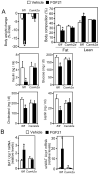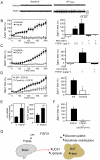FGF21 acts centrally to induce sympathetic nerve activity, energy expenditure, and weight loss
- PMID: 25130400
- PMCID: PMC4192037
- DOI: 10.1016/j.cmet.2014.07.012
FGF21 acts centrally to induce sympathetic nerve activity, energy expenditure, and weight loss
Abstract
The mechanism by which pharmacologic administration of the hormone FGF21 increases energy expenditure to cause weight loss in obese animals is unknown. Here we report that FGF21 acts centrally to exert its effects on energy expenditure and body weight in obese mice. Using tissue-specific knockout mice, we show that βKlotho, the obligate coreceptor for FGF21, is required in the nervous system for these effects. FGF21 stimulates sympathetic nerve activity to brown adipose tissue through a mechanism that depends on the neuropeptide corticotropin-releasing factor. Our findings provide an unexpected mechanistic explanation for the strong pharmacologic effects of FGF21 on energy expenditure and weight loss in obese animals.
Copyright © 2014 Elsevier Inc. All rights reserved.
Figures




References
-
- Arase K, York DA, Shimizu H, Shargill N, Bray GA. Effects of corticotropin-releasing factor on food intake and brown adipose tissue thermogenesis in rats. Am J Physiol. 1988;255:E255–259. - PubMed
-
- Bookout AL, Cummins CL, Mangelsdorf DJ, Pesola JM, Kramer MF. High-throughput real-time quantitative reverse transcription PCR. Curr Protoc Mol Biol. 2006 Chapter 15, Unit 15 18. - PubMed
-
- Cannon B, Nedergaard J. Brown adipose tissue: function and physiological significance. Physiol Rev. 2004;84:277–359. - PubMed
Publication types
MeSH terms
Substances
Grants and funding
LinkOut - more resources
Full Text Sources
Other Literature Sources
Medical
Molecular Biology Databases

